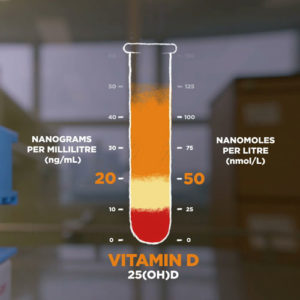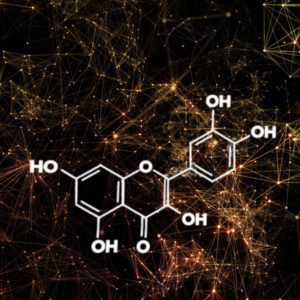Vitamin D is the only vitamin that we are able to get naturally from a source other than food – the sun. When sunlight hits our skin, the UV radiation transforms a type of cholesterol under our skin into a form of vitamin D called vitamin D3.
We can also create synthetic vitamin D by mimicking the biological process of the sunlight hitting our skin. We do this by replacing the cholesterol found in our body with the cholesterol in lanolin, a waxy-grease like substance found in sheep wool. This synthetic or man-made form of vitamin D3 is what is commonly sold as vitamin D3 supplements in shops.
Professor Mark Rizzacasa and PhD student Calvin Lee from the School of Chemistry at Melbourne University calculated that you can produce one million 25 microgram doses of vitamin D3 from the fleece of one sheep.
The results were so astounding that we asked PhD student Calvin Lee to re-create this process for us. He did and this is how.
To see how Calvin came to these figures, see his workings below.
This work was done in the Rizzacasa Group, under the supervision of Professor Mark Rizzacasa.
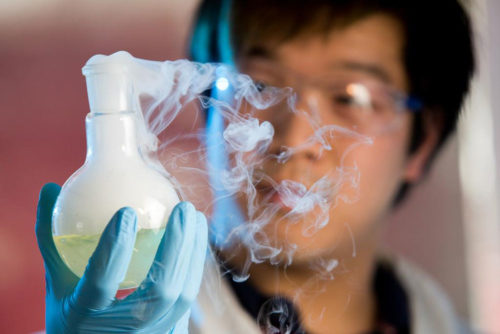
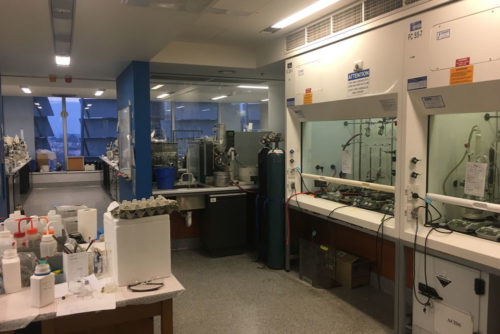
The synthesis of vitamin D is a multi-stage process, beginning with 7-dehydrocholesterol extracted from the lanolin found in greasy sheep’s wool. This is irradiated with high-intensity light to form preform vitamin D and then heated to form our final product vitamin D3.
Step 1
1) I started with 50 milligrams of 7-dehydrocholesterol to perform this reaction. This amount is about the same size as a quarter of a tic tac. With a reported synthetic yield of 61% I should get around 30 milligrams of vitamin D3!
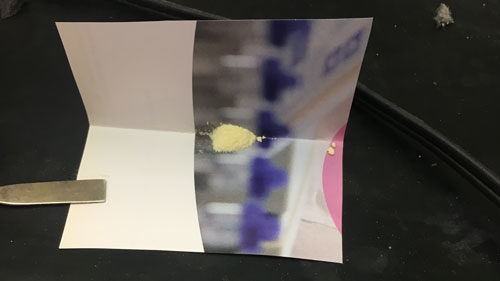
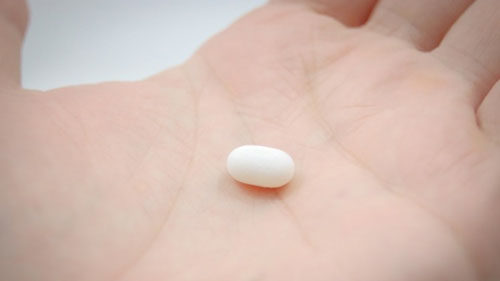
Step 2
I then placed the 7-dehydrocholesterol in the reaction chamber (1) along with an ultra-violet mercury lamp (2) that will irradiate it, converting it to vitamin D3.
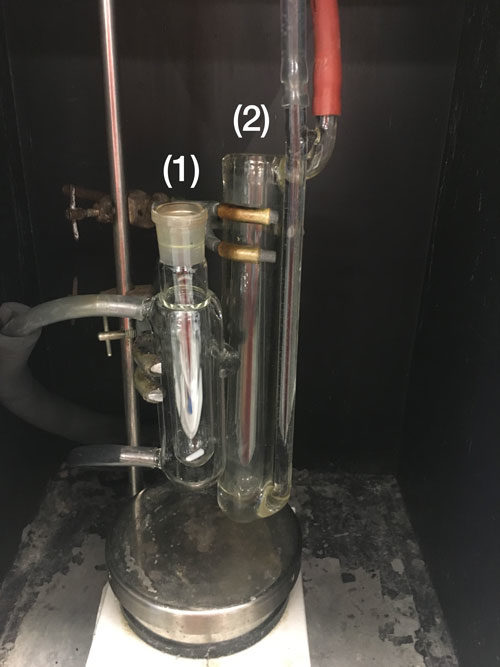
The ultraviolet lamp generates a lot of heat, which could cause the conversion of 7-dehydrocholesterol to fail. The cooling tubes coming out of the chamber will keep the reaction’s temperature at 0 degrees Celsius once the reaction starts.
I’ve kept the lamp in its own chamber, on the right. The lamps itself is kept cool with running water that is 15 degrees Celsius. This makes sure the expensive lab equipment keeps functioning as well.

It is important for this reaction to continuously stir the contents. If you look closely at the picture below, you’ll see I’ve placed a magnetic stirring bar (3) and silver plate (4) below it in the reaction chamber. The silver plate creates a magnetic field that spins the stirring bar, causing it to spin continuously.
Step 3
I then added 10 mL of ethanol to dissolve the 7-dehydrocholesterol and allow it to react more efficiently.
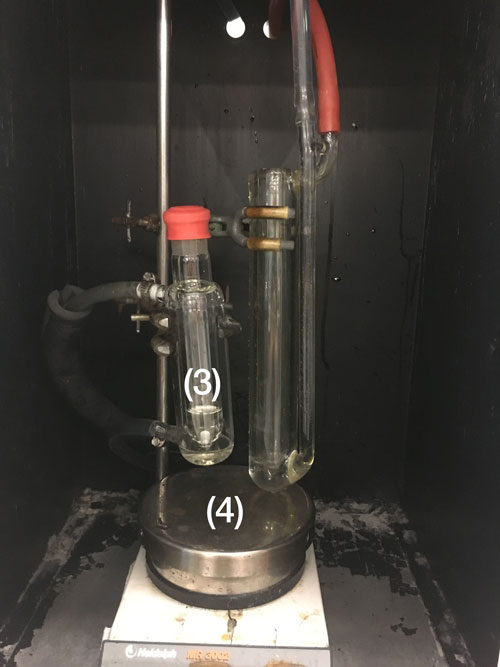
And then wrapped the whole thing in kitchen aluminium foil so that the high-intensity light was concentrated solely around the reaction chamber.
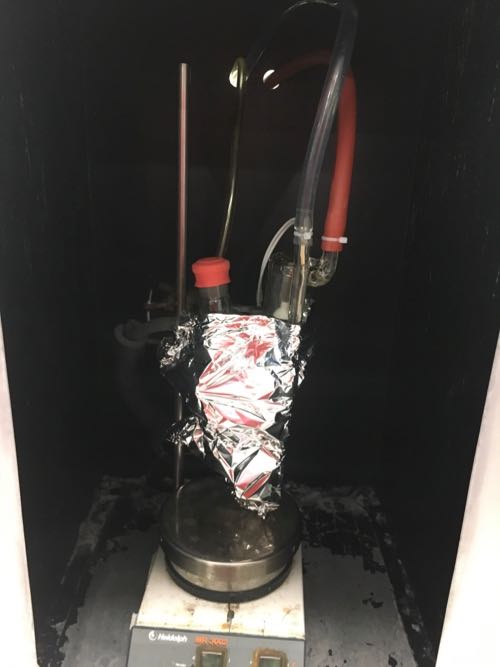
As the ultraviolet light is very damaging to the eyes, the reaction needs to be performed while sealed and enclosed in a box. This is the open box….
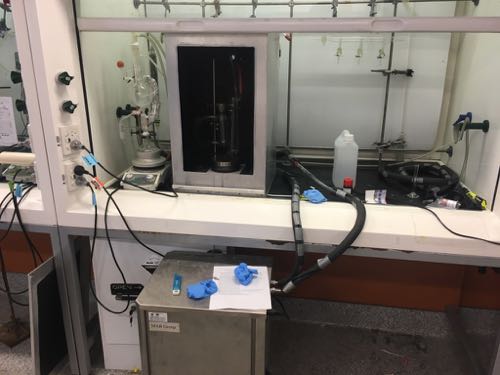
And closed. That’s my reflection.
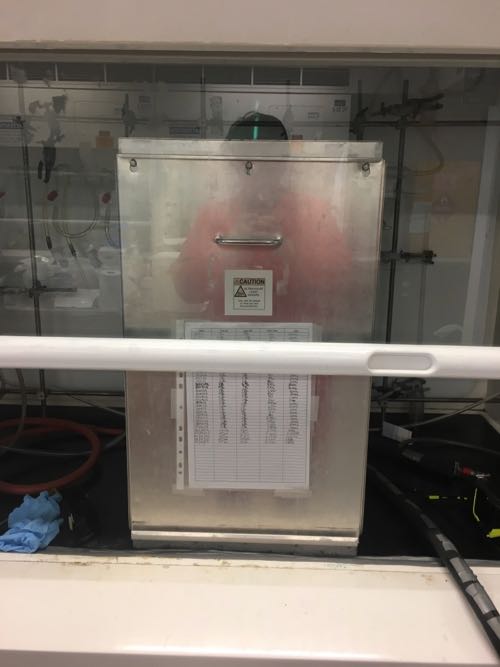
Step 4
I irradiated the solution with 200-400 nm wavelength light for roughly 15 minutes. This type of UV radiation simulates the ultraviolet-to-green portion of the sun’s light. However, ultraviolet light is beyond the capabilities of the human eye to observe, so all we see is an eerie green glow.
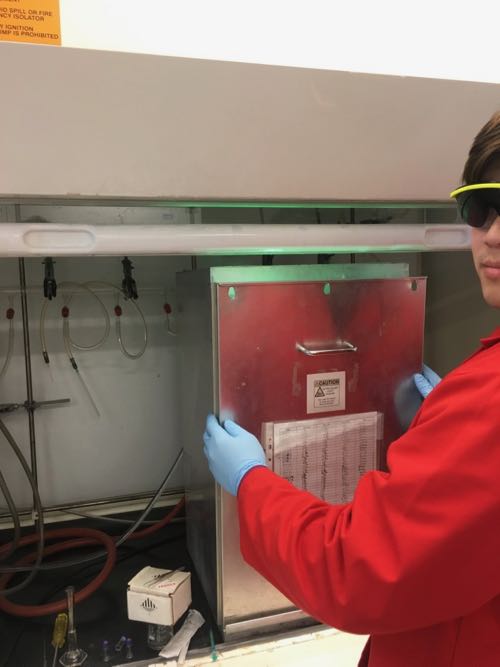
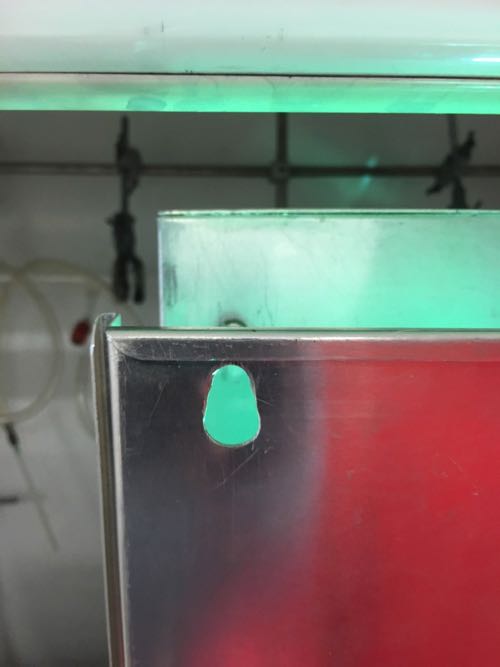
Step 5
After the sample is irradiated I transferred the pre-vitamin D into a round-bottom flask (5) so that it could be heated to transform into vitamin D3. The glass column (6) above the round-bottom flask is a condenser full of cold water, this allows the ethanol (7) to be heated to above its boiling point without it evaporating.
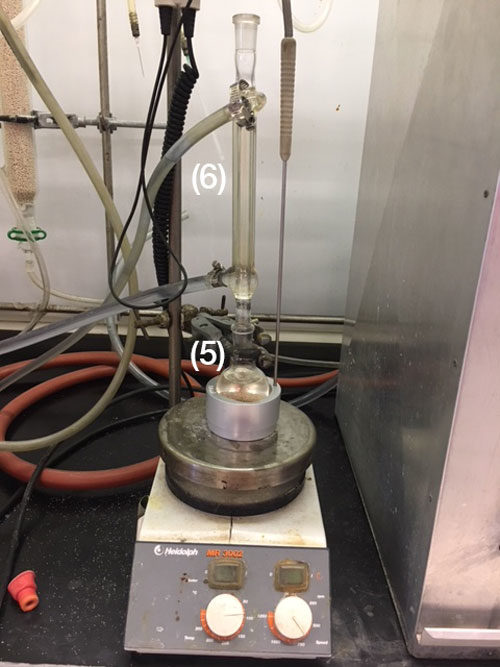
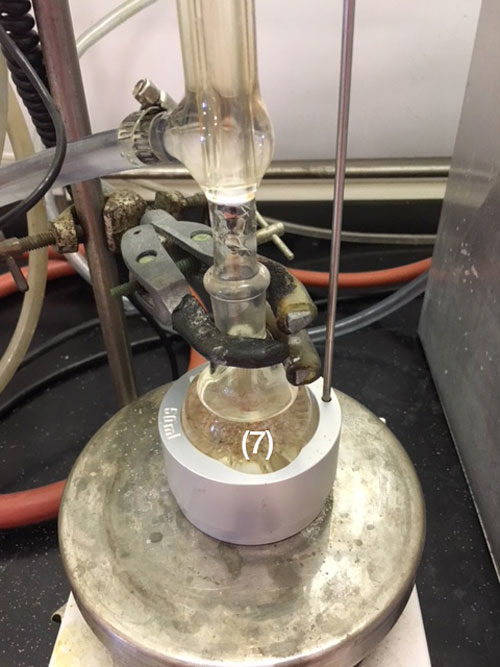
Step 6
Once the reaction is complete, we use a rotary evaporator (8) to remove the unneeded ethanol. It creates a partial vacuum so that we don’t need to heat it past its boiling point and risk damaging our product. It’s also much faster this way.
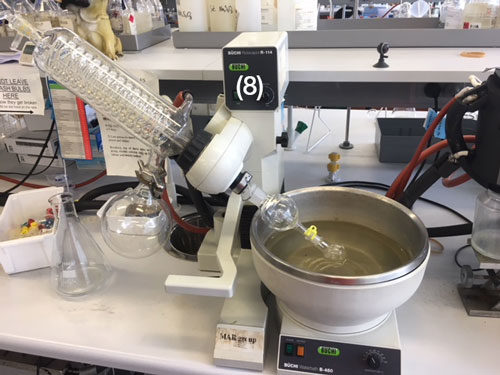
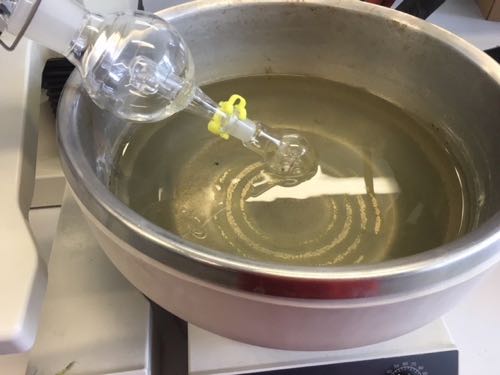
Step 7
After I removed the ethanol with rotary evaporator all that was left was a colourless powder coating the round bottom flask. This powder is a mixture of ~20% vitamin D and ~80% unreacted 7-dehydrocholesterol. Upon further purification (by chromatography), we’d obtain the synthesised vitamin D3 made in a chemistry lab using our biological process as the template.
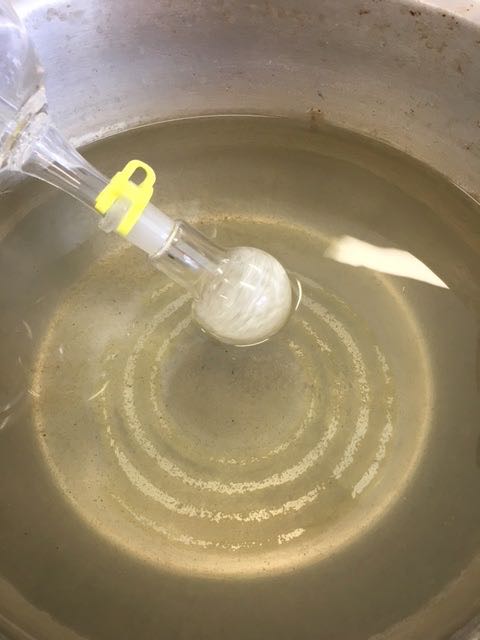
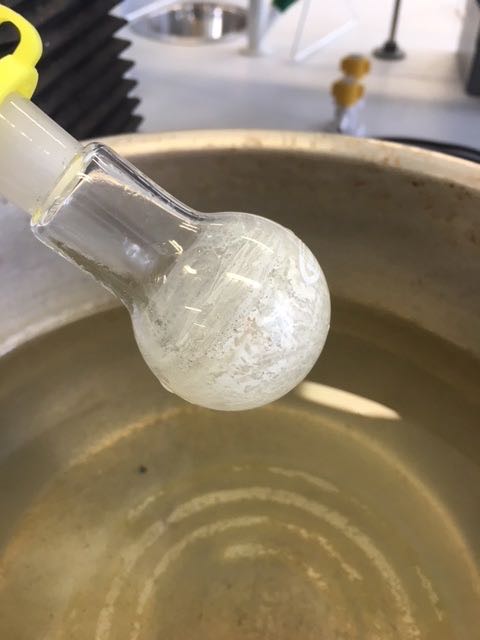
And here it is, collected in a glass plate. Doesn’t look like much, does it? Yet this tiny amount of powder – about half the size of a five-cent coin – is worth over a hundred dollars.

While this reaction may make synthesizing vitamin D look easy, it’s not. It takes a skilled hand to run the experiment safely and measure out the tiny quantities that our bodies can handle on a daily basis, or we risk overdosing! So please, please don’t try this at home.
If you have any questions please consult a medical professional as high doses, if administered incorrectly, can be harmful and even fatal.
The information contained in this article should not replace the advice of a healthcare professional.
The average Merino sheep gives 6 kg of wool per coat[1]
Of this 6 kg weight, 30% is crude lanolin or wool wax[2] (1.8 kg)
Of this 1.8 kg of crude lanolin, about 20% of this is recoverable wool grease or purified lanolin[3] (360g)
Given that lanolin has a density of 0.932 g/mL at room temperature[4], this translates to around 336 mL of wool grease.
This matches with figures extracted from another source ‘the wool from one merino sheep will produce about 250-300 mL of recoverable wool grease’[5]
Using the more conservative estimate, the 250 mL (or 268 grams) of wool grease is made of 38% cholesterol content by weight[6],[7] (101 grams).
Efficiency numbers of industrial conversion from cholesterol to 7-dehydrocholesterol could not be found, but lab-based results[8] suggests a 34.6% efficiency, giving us 35 grams of 7-dehydrocholesterol
Industrial photochemical irradiation of 7-dehydrocholesterol and purification to Cholecalciferol (Vitamin D) is around 74% efficient[9], giving us 26 grams of pure Vitamin D.
Vitamin D supplements often contain 25 micrograms of cholecalciferol in each pill[10][11][12].
If there are 25 micrograms of cholecalciferol in each Vitamin D pill, then one sheep will gives us 26 grams of cholecalciferol which will give us roughly one million pills (1,043,005).
Or if you look at these calculations another way, if packaged into pills and then sold, the vitamin D3 from one sheep would then be worth over $3,700 per gram—that’s more than the price of gold!
And this is just from the oily residue on the fleece that the wool-makers don’t use.
REFERENCES
[1] http://merinos.com.au/genetics/merino-history/australian-merino
[2] Production and oxidation of wool grease after shearing, Australian Veterinary Journal (1999)
[3] https://archive.org/stream/woolgreaseeconom89raym/woolgreaseeconom89raym_djvu.txt (Table 3)
[4] https://www.chemicalbook.com/ProductMSDSDetailCB3463970_EN.htm
[5] Comprehensive view on chemistry, manufacturing & applications of lanolin extracted from wool pretreatment, American Journal of Engineering Research (2014).
[6] Comprehensive view on chemistry, manufacturing & applications of lanolin extracted from wool pretreatment, American Journal of Engineering Research (2014).
[7] http://lanolin-stella.com/wp-content/uploads/2013/10/Lanolin-Alcohol-Cosmetic-grade-with-high-Cholesterol-content.pdf
[8] Synthesis of 7-dehydrocholesterol through hexacarbonyl molybdenum catalyzed elimination reaction, Bulletin of the Chemical Society of Ethiopia (2011)
[9] https://www.google.com/patents/US3157678#v=onepage&q=&f=false
[10] https://www.chemistwarehouse.com.au/buy/84677/Wagner-Vitamin-D3-1000IU-250-Capsules?gclid=EAIaIQobChMI5I2V99Tj2wIVS4ePCh3NcwQeEAAYASAAEgJ00fD_BwE
[11] https://www.chemistwarehouse.com.au/buy/55289/Blackmores-Vitamin-D3-1000IU-200-Capsules
[12] https://www.chemistwarehouse.com.au/buy/69162/Swisse-Ultiboost-Vitamin-D-400-Capsules
